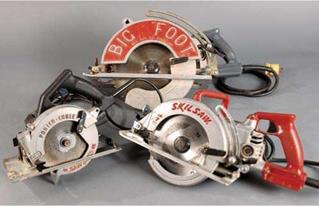PLUMB AND LEVEL
A plumb bob takes patience to use, but it’s a compact, accurate tool. The plumbed string is also a useful reference line you can measure out from. The Gammon Reel® shown in the photo on the next page automatically reels in the string so it can’t tangle up in a tool pouch.
A 4-ft. spirit level is a good, all-purpose level, long enough to level accurately across joists, check for level and plumb of door and window casings, and so on.
A 2-ft. spirit level enables you to level window sills, door head jambs, and other tight spaces where a 4-ft. level won’t fit.
A standard torpedo level is small and fits into a tool pouch. Though it’s not as accurate as a longer level, it’s good for a quick reference in

![]()


tight spaces. Magnetic versions can stick to cast – iron pipe.
A torpedo level with a laser has the same limitations as any torpedo level, but its laser allows plumbers to set the tool on a pipe that’s pitched correctly and extend that pitch (indefinitely) to other pipe sections.
Circular saws are generally characterized as either worm-drives or sidewinders and are often called Skilsaws®, the name of a popular brand.
Among professional builders, especially on the West Coast, worm-drive circular saws are favored for cutting framing lumber. They tend to have bigger motors and more torque. They also spin slower, bind less, and run quieter than sidewinders. If you’re right-handed, worm-drive saws make it easier to see the line you’re cutting.
Sidewinders are generally lighter and more compact, so they’re easier to handle and a good choice for the occasional builder. But because the blade is turning at 90° to the motor shaft, it is more likely to bind if your cut wanders off the line. For that reason, a rip fence is a nice accessory.
Beam saws are called "sidewinders on steroids” because they can accommodate 10-in. blades that cut smoothly through 4x lumber in one pass. It’s not a must-buy item, but wow, what a tool!
For circular-saw blades in general, the more teeth, the smoother the cut. If you buy just one, make it carbide tipped; it will stay sharp far longer and give cleaner cuts. There are specialty blades for almost anything you’d want to cut: tile, concrete, metal, and wet or pressure-treated lumber (has a Teflon™ coating). Remodelers’ blades cut through wood and the occasional nail without being damaged.
A reciprocating saw, also called a Sawzall® after a popular make, is the indispensable demolition saw. A marvel in tight spaces, it can remove old pipes, cut through studs or joists or, with a bimetal blade, cut through nails and studs in one pass. (Blades break, so get extras.) A “recip” saw is also useful in new construction to notch studs for pipes, cut plywood nailed over rough openings for windows and doors, and so on.
Jigsaws, sometimes called saber saws, are useful for notches, curving cuts, and odd-shaped holes. Typical uses include cutting out holes for sinks in countertops and holes in cabinet backs so pipes or ducts can pass through. The blades are thin and prone to snap, so buy extras.






Leave a reply